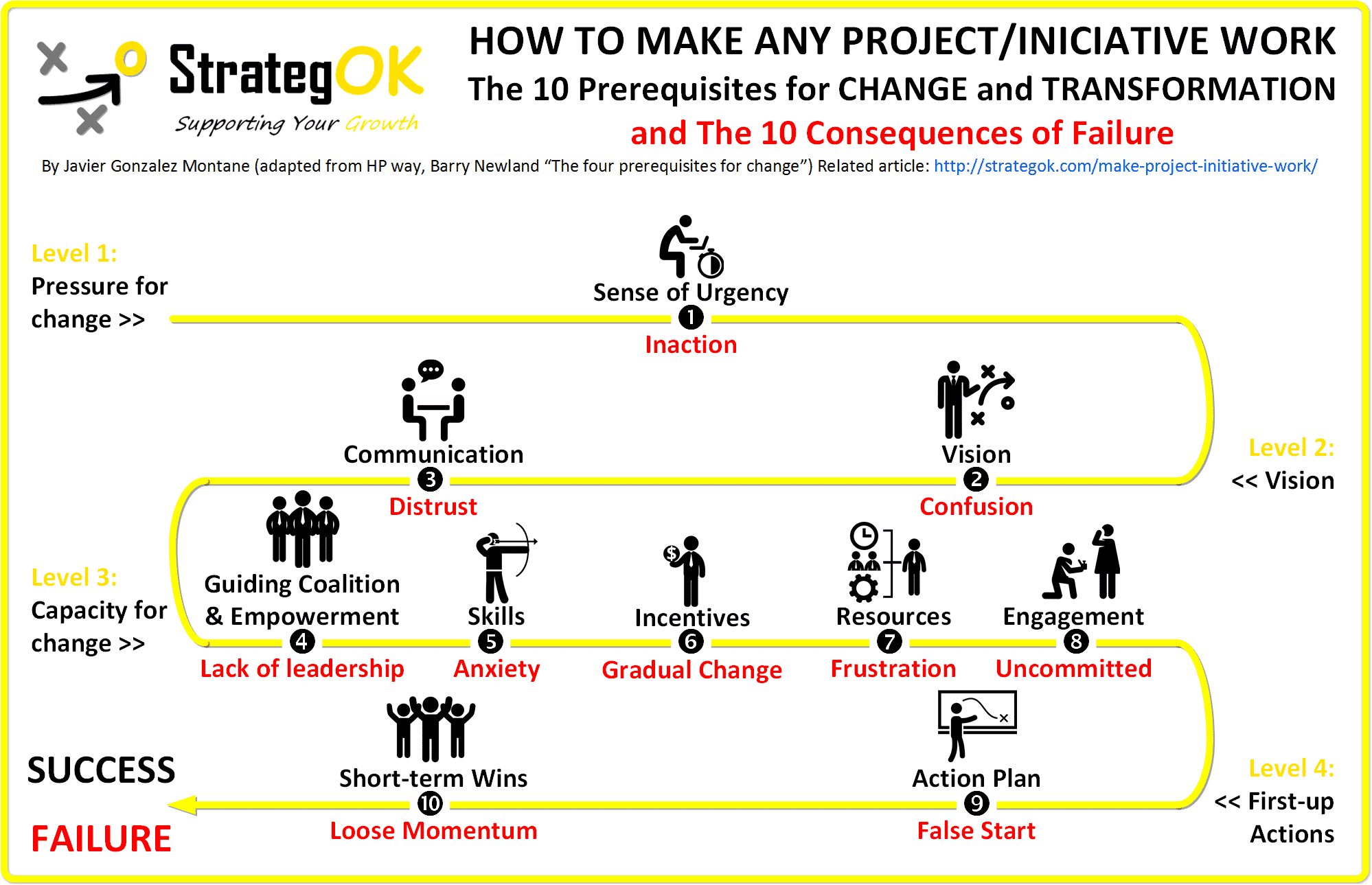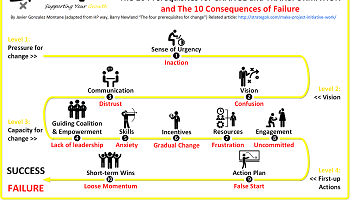It is well-known that 70% of all change and transformation efforts fail. So we are presenting a snappy 10 steps journey to guarantee that “good” turnarounds, transformations, strategic initiatives, projects and so on work and do not fail in the implementation phase.

The 10 Prerequisites for change and transformation
Let’s review briefly any step of this framework adapted from HP way, Barry Newland “The four prerequisites for change” and completed with ideas of other relevant authors like John P. Kotter or Richard Bevan.
1. Sense of urgency: The sense of urgency is what keep people going. Without this sense any project or initiative have a slow start with the risk of losing momentum. Urgency is key because is an important “wake-up call” to provoke action. Unfortunately, there are large firms that fail in this first step because of self-complacency and over optimism. So they are not able to recognize the severity of some business issues/risks. On the other hand, SME many times justified their lack of urgency because they have limited resources.
2. Vision: Without vision there is not direction. So the consequence of failing to build a concise easy to communicate/understand and realistic vision is confusing people. We have to highlight that the vision must be realistic in order to be adopted.
3. Communication: If the vision is not communicated, how can we expect to be properly implemented? There are two common mistakes in communication: first think that the vision is shared just with managers rather than with the whole company. “Hidden” this “non-confidential” and necessary information for employees creates distrust and demotivation; second oversimplified the vision communication, so people do not understand what is exactly expected from them; and third thinking that communication is just one off communication rather than a continue communication process during many months using any opportunity to reinforce the message until the whole organization internalize and execute the vision properly.
4. Guiding coalition and empowerment: Without the support of the company leaders and some influencer managers at different organizational levels, it is difficult to implement large initiatives like turnaround or transformation ones. As Kotter said “a paralyzed senior management often comes from having too many managers and not enough leaders.” In those situations used to be necessary a few interim management positions to build a success guiding coalition and a real sense of urgency and change. For more details of guiding coalition, please see our short article about “bunker concept.”
5. Skills: Bad leaders used to distribute tasks that should not be performed without checking, if the team members had the right skills for those tasks. So they create anxiety on unskilled people. Good leaders coach and train the team what will probably consume a huge amount of time, for this reason many times are required of external support to build an outstanding organization.
6. Incentives: Why is anyone going to get out of his/her comfort zone? The incentives accelerate or decelerate the change and transformation process. There are two common mistakes: first, think that motivation could be just pure recognition of the work performed. Recognition is a necessary condition but it is not enough. The highest recognition of a company is sharing a portion of the profit with employees who make it happen. So promotion and bonus plans should be in place to celebrate the success and maintain momentum; the second mistake is ignoring the power of “pain” in case of failing. The job of good leaders is to make to success their team members providing coaching, training, resources, and so on. Using “pain” like a motivator is not easy because it could create anxiety especially on unskilled people. Thus, this should be used carefully just on people that they can perform much more but they are “relaxed” or sabotaging the project.
7. Resources: Leaders must provide the necessary resources to the team. It is important to explain at the very beginning of the project the resources available and why in order to prevent future frustrations of any team members. Success turnaround and transformation initiatives have into consideration the need of external support resources to seek competitive advantage without disrupting daily operations.
8. Engagement: The success of the guiding coalition depend on their skills to build a sense of ownership and commitment. This is a very difficult task that is taking many months because of affect to the culture of the firm. Without ownership and commitment, just chaos could be expected.
9. Action plan: Some leaders confuse vision and action plan. Thus, they just build a nice vision and they get surprised when the implementation is not happening. Basically, the absence of an action plan makes no possible have detailed enough of activities necessary to materialize the vision.
10. Short-term wins: Large transformational initiatives require to be divided in affordable steps that maintain the momentum. Those wins must be celebrated and rewards in order to sustain the improvements.
